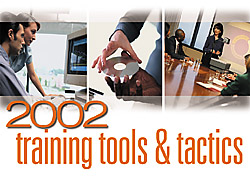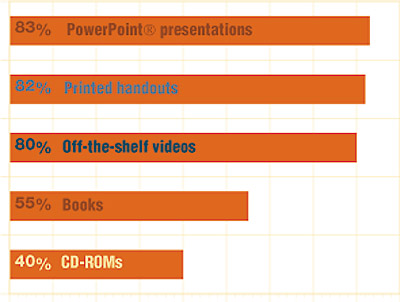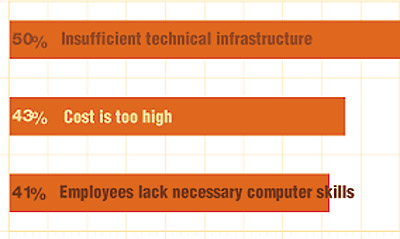

Nowhere is the tech-savvy nature of today's pros more evident than in the training classroom. Microsoft PowerPoint presentations turn out to be the number one training tool, according to ISHN's 2002 training survey. The top training materials readers plan to use this year are shown in Graph 1.
PowerPoint's heavy use probably stems from the software's ability to meet several "critical success factors" for safety training, as defined by readers in the survey:
- 79 percent of ISHN survey respondents say creative instruction is very important;
- 77 percent say content must be customized to their operations; and
- 68 percent want presentations to be easily changed, corrected and updated.
PowerPoint delivers on each of these counts.
Whither online training?
Note that Web-based training doesn't crack the top five tools for 2002. It may indeed be the "fastest-growing training medium," as heralded in a January 2002 press release from the National Safety Council, but change - technological or otherwise - doesn't happen overnight in the occupational safety and health field, and right now a minority of safety and health managers are using online training for employees.This is just one of the findings from a survey of 1,000 readers of Industrial Safety & Hygiene News magazine conducted in February 2002. One-hundred-and-fifteen readers responded, for a 12 percent response rate.
Twenty-nine percent of those responding now use online safety and health training via the Internet or an intranet server. That number could be inflated by a survey bias: individuals currently using online products might be more likely to take the time to complete ISHN's 14-question survey than those with no interest.
The survey is not broad enough, nor the response rate high enough, to be definitive. But it provides a revealing snapshot about current training tools and tactics. And the attitudes and experiences relating to online safety and health training we found are in line with similar research efforts.
For example, a 2000 study by the National Safety Council of members and nonmembers found 19 percent using the Internet or an intranet site for training.
A 2001 survey of attendees at the American Industrial Hygiene Conference & Exposition found 30 percent had used "teleweb/Internet/Web" distance learning tools/formats in the past.

Live presentations preferred
Almost every respondent toISHN's survey (94 percent) says they will use in-house, instructor-led training (lecture and/or video) in 2002. The second most popular delivery method: hands-on demonstration training (79 percent). Number three: hiring outside instructors to conduct training onsite (55 percent).Live instruction still dominates because it satisfies the critical success factors for safety training defined in ISHN's research. (See Graph 2.)
This doesn't mean technology has a limited future in safety training. Tech tools already are a major force, as we've seen, with more than four out of five safety and health managers using PowerPoint presentations in 2002.
Professionals are too tech-savvy to be blind to the benefits on online training. Only 25 percent dismiss online training as any kind of priority at their company. And only 26 percent say they flat-out prefer traditional classroom books, videos and tests.
About one-third of those surveyed (31 percent) are still considering making online training part of their safety program. And very few (18 percent) have not at least explored online training products.
Online advantages
Here's what safety managers like about online training, according toISHN's survey:1. Flexibility - the ability to take online courses any time (cited by 75 percent);
2. Documented recordkeeping - the ability to track who's been trained and when (67 percent);
3. Saves time in the training area (58 percent);
4. Provides consistent training in multiple locations (51 percent).
These advantages can make for better training. Eighty-one percent of ISHN's survey respondents say efficient recordkeeping is a very important factor behind training success. And 55 percent say the ability to conduct training in shorter periods of time is very important.
Seeing these online benefits, most safety and health managers surveyed (52 percent) say they prefer a mix of traditional and online training. How quickly this "bricks and clicks" blend of old-school and high-tech training occurs depends largely on organizational issues beyond the control of most safety and health managers. As one says, "It (computer-based training) never gets to the top of the priority list."
Certain "market niches" or types of users might take to online training more quickly:
- Fortune 500 corporations vs. mom and pop shops;
- Technology-based corporate cultures vs. conservative, old-school cultures;
- Companies that emphasize and invest in information systems and training departments;
- Corporations with far-flung operations or franchises requiring consistent training and recordkeeping;
- Companies with high employee turnover and a strong need for orientation and/or refresher training (good topics for online training).
Also, companies with active intranet sites are more likely to embrace online training. In 2002, 27 percent of ISHN survey respondents say they will use training delivered from their company server - compared to only 7 percent using Internet-based training. Clearly, security, control and ownership are issues with online training.

Obstacles to overcome
According toISHN's research, the main reasons for not using online training are shown in Graph 3.Comments from respondents reinforce these factors:
- "Hourly employees are not allowed to use company computers."
- "We do not have time to allow for one-on-one computer use."
- "A significant portion of Southern California employees have limited knowledge of English and poor technical skills."
Three other issues come into play:
Selection considerations
But ISHN's survey indicates there's no going back: more safety and health programs will incorporate online training in coming years. As the trend continues, safety manager Vince Laquidara says it's important to remember:
- Online training is a major change. Most people resist change and some people will look for ways to undermine it.
- Hooking up with the wrong training provider or having the wrong expectations will kill any efforts in this area.
- The quality and breadth of the products offered by the training provider is a major consideration.
- As online technology progresses, there will be errors and shortcomings. How customers and providers respond to these shortcomings is key. Watch out for the, "I want it right the first time" mentality.
- Do your potential vendors: specialize in training, or software development, or both?; provide adequate customer service?; really understand your needs?
- Students must be flexible and providers must be willing and able to change the products to meet new demands.
Over time, organizational barriers will crumble (not enough computers, not enough bandwidth, etc.), so ask yourself: Are you ready for the changes that come with online training? Are your employees ready? Hardware and software issues and technical support aside, do you and your employees have the right mindset and expectations? All of these are keys to getting the most out of an online training experience.
SIDEBAR: Waiting to connect - Why online training is growing slowly
Two years ago ISHN surveyed readers and found 28 percent planned to use online training products in 2000. Our latest survey shows virtually no growth in usage.Still, most safety and health managers surveyed by ISHN in 2002 are bullish about future applications of online training. Sixty-one percent of current non-online users expect to be engaged in online safety training within the next three years. If those projections hold true, we'll see a dramatic shift in how safety training is conducted. Online training would move from a relative rarity (with less than one-third of safety managers now using products) to an industry standard.
Will that kind of exploding growth occur so rapidly?
After all, the recent economic recession has curbed appetites for capital spending on information technology. Sixty-nine percent of the respondents to ISHN's survey in February 2002 report that their budget for safety training will not increase this year. Twice as many report training budget cuts (21 percent) versus budget boosts (10 percent).
Funding is only one problem, but a powerful one. ISHN's survey asked respondents to describe how online safety products could be improved, and time and again they raised the issue of cost:
"Cost is a factor." "Cut costs." "Costs are too high." "Keep costs low and reasonable." "Needs to be affordable."
The range of spending on online safety training is so broad, according to ISHN's survey, it makes any kind of average expenditure difficult to estimate. Respondents say they will spend anywhere from $200 to $60,000 on online safety training in 2002. Most will spend between $1,000 to $5,000.
Pricing isn't the biggest barrier, though. Reason number one for not using online training is this: 50 percent of non-users say their company lacks sufficient technical infrastructure: Not enough computers to go around. Computers that are too old. Internet access that is too limited or narrow to permit sophisticated streaming video. Security "firewalls" that are inadequate or don't exist.
The ratio of computer workstations to employees varies so widely from one facility to the next it's almost impossible to come up with a standard benchmark, according to ISHN's study. Some workplaces have every employee on a computer; in others, there might be one computer for every 100 employees. We estimate the ratio to be in the range of one computer for every six to 13 employees.
SIDEBAR: OSHA's take on online training
OSHA's long shadow looms large over practically every safety issue, and training is no exception. Safety managers seem confused about OSHA's position on online training. "Full OSHA acceptance is needed," says one respondent. "Online training is not OSHA compliant," says another.OSHA's position is obscure, but spelled out in three letters of interpretation written by officials in response to queries from the field. One point worth noting: OSHA does not approve or endorse specific training programs. Also, employers must give trainees the chance to ask questions and receive answers, according to OSHA. When Web-based or computer-based training is used, a telephone hotline or email satisfies OSHA's requirement, if responses come from a qualified trainer in a timely manner.
In a 1997 letter, OSHA stated that "it is unlikely that sole reliance on a computer-based training program is likely to achieve" objectives such as hands-on training and exercises and the opportunity to ask questions about unfamiliar material.
SIDEBAR: Online learning curve
Don't blame ignorance for the slow conversion to online training. More than half of those responding (53 percent) to ISHN's survey say they have a good grasp of the pros and cons of online training.These issues are spelled out in the new ANSI Z490.1-2001 standard on effective safety training. Advantages include:
- Automated recordkeeping
- Self-paced training that can be offered at any time
- Simultaneous training of employees from different facilities
Special issues include:
- Trainee feedback is essential
- Trainees must be comfortable with and knowledgeable in how to use the technology
- Set-up costs can be high
Only 36 percent of ISHN's survey respondents say they do not know enough about online training to understand and select a system. Only 17 percent believe their current knowledge about online systems and vendors is lacking.
SIDEBAR: Where to find training on the Web
Vendors -- AdvanceOnline, Inc.
Barrett Business Services, Inc.
Business & Legal Reports
Comprehensive Loss Management, Inc.
Coastal Training Technologies
Core Media
DuPont Safety Resources
EduNeering, Inc.
Environ.com
Environmental Health & Safety Online
esafetyonline.com
Government Institutes
HazMatSchool.com
HR On-line
J.J. Keller
KnowledgeWire.com
Less Stress Instructional Services
Moxie Training
OnlineSafetyTraining.com
PureSafety.com
Personal Best Systems
Primedia Workplace Learning
SafetyAdvantage.com
Safety Alert Network
SafetyCampus.com
Safetyinfo.com
SafetyLogic.com
SafetyPages.com
Saftek.com
Summit Training
TargetSafety
The Training Registry
TrainingOnline.com
Video-Safety-Training.com
www.free-training.com
WorldWideLearn.com
Associations -
- American Industrial Hygiene Association
American Society of Safety Engineers
Laser Safety Organization
National Fire Protection Association
National Safety Council
RMIS.com
Government -
- Federal Emergency Management Agency
OSHA.gov
Oregon OSHA
Consultants -
- Beacon Mutual Insurance Co.
Behavioral Science Technology
EMR Consulting
Liberty Mutual
Safety Performance Solutions
Educators -
- Eastern Michigan University
Harvard
Oklahoma State
Vanderbilt
Note: This list is not all-inclusive. To find these sites, type the name of the company in your favorite search engine. These sites turned up on a Google search.